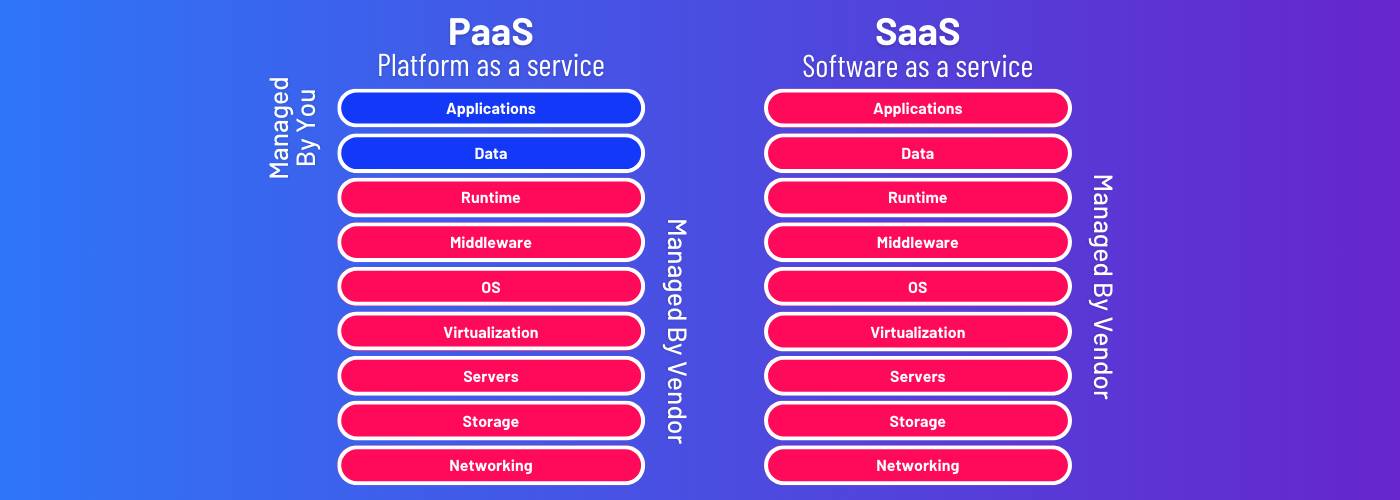When it comes to cloud computing, there are various models that cater to different business needs. Two popular options in the market are Platform as a Service (PaaS) and Software as a Service (SaaS). While both fall under the umbrella of cloud services, they serve distinct purposes and offer unique benefits. We’ll be taking a look at PaaS vs SaaS.
What Is PaaS and SaaS?
Software as a Service (SaaS) and Platform as a Service (PaaS) are two essential components of cloud computing services that have revolutionized the way businesses operate.
SaaS refers to the delivery of software applications over the internet, allowing users to access these applications through a web browser without needing to install or maintain any software on their own devices.
This model frees businesses from the hassles of managing complex infrastructure, updates, and security patches, making it an ideal solution for companies looking for cost-effective and scalable software solutions.
On the other hand, PaaS provides developers with a platform to build, test, and deploy their own custom applications. It offers a complete development environment that includes tools for coding, testing frameworks, databases, and servers.
With PaaS, developers can focus on writing code instead of worrying about infrastructure management.
Benefits of PaaS & SaaS
One of the key advantages of PaaS is its ability to streamline development processes and speed up time-to-market for applications. With PaaS, developers can focus on writing code and building applications without having to worry about managing underlying infrastructure or dealing with complex setup processes.
This allows them to be more productive and efficient in delivering high-quality software solutions.
Another benefit of PaaS is its scalability and flexibility. PaaS providers offer a range of resources, such as computing power, storage, databases, and networking capabilities that can be easily scaled up or down based on the needs of the application.
This elasticity allows businesses to handle fluctuations in traffic or user demand without any disruption in service.
On the other hand, SaaS offers its own set of benefits that users should be aware of. One of the key advantages of SaaS is its cost-effectiveness.
Instead of purchasing and maintaining expensive hardware and infrastructure, users can access software applications through the cloud on a subscription basis. This eliminates the need for upfront investments and allows anyone to pay only for what they use, reducing overall IT costs significantly.
Another benefit of SaaS is its flexibility and scalability. With traditional software, users often face challenges when it comes to upgrading or customizing their systems. However, with SaaS solutions, updates are automatically deployed by the service provider without any disruptions or additional expenses for the user.
Additionally, as companies grow or change their requirements, they can easily scale up or down their subscription plans based on their needs.
What Are The Cons of PaaS & SaaS
Like any technology solution, PaaS also comes with its fair share of drawbacks. Understanding these cons is vital for anyone considering implementing PaaS into their operations.
One major disadvantage of PaaS is limited control over the underlying infrastructure. With PaaS, the provider manages the hardware and software stack, which means users have little visibility or control over the underlying resources.
This lack of control can be challenging for organizations with specific security requirements or regulatory compliance needs. Additionally, if there are issues or disruptions on the provider’s end, it can impact the availability and performance of applications running on the platform.
Another drawback of PaaS is vendor lock-in. Because PaaS providers manage the underlying infrastructure, users typically have little choice but to stick with the provider. Choosing a different provider can mean starting over with a new application suite or re-architecting an existing application.
However, it’s important to note that Sharktech is one of the few providers offering customizable solutions to PaaS and SaaS.
When it comes to SaaS, it has its own set of drawbacks as well. One of the main drawbacks of SaaS is the lack of control over data security and privacy.
When using SaaS applications, companies must entrust their sensitive data to third-party vendors who are responsible for storing and protecting that information. This can be concerning for organizations dealing with highly confidential or regulated data, as they might not have complete visibility into how their data is being handled.
Just like PaaS, SaaS has the potential for vendor lock-in. Since companies rely on external providers for their software needs in a SaaS model, switching to another service provider can be challenging and costly.
Who Needs PaaS & SaaS?
Who exactly needs PaaS? The short answer is any organization or individual looking to streamline their application development process and maximize efficiency.
Firstly, startups and small businesses can greatly benefit from PaaS. With limited resources and manpower, these entities often struggle to set up their own infrastructure for application development.
PaaS provides them with a turnkey solution that eliminates the need for costly hardware setups or software licenses. It allows them to focus more on the core aspects of their business by taking care of all backend operations like scaling resources and maintaining security.
Secondly, enterprises that require agile development environments find great value in adopting PaaS. It allows them to quickly develop applications on top of their existing infrastructure without the need for additional resources.
However, what about any entity that isn’t small and requires large amounts of data, CPU, power, etc? Then, this is where SaaS comes into play. Almost every large business or entity can benefit from this innovative cloud-based solution.
Firstly, entities that lack the resources to invest in expensive software licensing fees and hardware infrastructure find great value in SaaS cloud hosting. By subscribing to a monthly or annual plan, they gain access to powerful applications at an affordable cost.
Moreover, with SaaS, these businesses no longer have to worry about regular updates and patches – everything is taken care of by the service provider.
Secondly, large enterprises can also benefit from adopting SaaS solutions. For one, most SaaS providers offer affordable plans that are suitable for small departments or specific business units. In addition, they can also benefit from the increased flexibility and scale of these applications as compared to in-house software.





More to Read
The OpenStack Public Cloud Complexity Problem (And Why It’s Costing You)
Choosing the right cloud platform today is akin to trying to pick a needle
Oct
Make Growth and Security Part of Your Public Cloud Management Strategy
Managing today’s cloud infrastructure is no longer just about spinning up servers or
Sep
Leading Cloud Service Providers Explained: Types, Benefits, and How to Choose
94% of businesses now use a cloud solution in some form. Whether it’s
Aug
What is Public Cloud? A Simple Guide For Businesses
What is public cloud? It’s a model of cloud computing where infrastructure and
Jul
What is Cloud Migration? A Practical Guide for Modern Businesses
What is cloud migration? It’s the process of moving digital assets—like data, applications,
Jul
Why Some Businesses Choose Self-Managed Cloud Instead
Cloud computing has revolutionized how businesses deploy, manage, and scale their digital infrastructure.
Apr